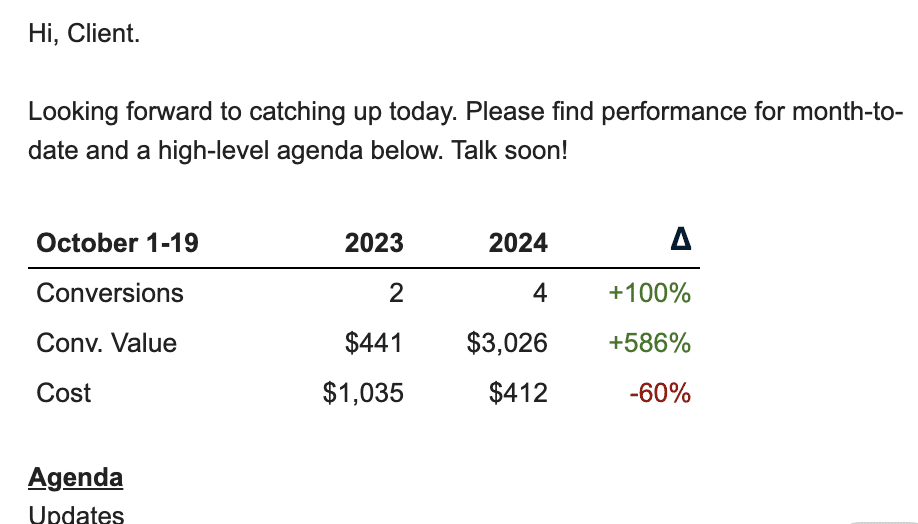
Over the past decade, I’ve sat through roughly 1,175 PPC client meetings – yes, I did the math.
While experience is the ultimate teacher, sometimes the next best thing is learning from someone who’s been through it all.
This article discusses my most tried-and-true tips for running more effective and impactful PPC client meetings.
1. Don’t neglect your primary KPI
Your primary PPC KPI should always be at the forefront of discussions.
It’s easy to keep the KPI top-of-mind at the beginning of an engagement, but just as easy to start ignoring it as the months (or years) go by.
I include the primary KPI performance in every interaction I have with my PPC clients, whether that’s a monthly reporting email with a simple table or a meeting where I add performance metrics to the agenda or notes.

It’s the rare client who can stay laser-focused on the primary KPI over the months and years, so set yourself up for success by making it second nature to always know how the account is doing for the one metric that matters most.
Keeping the primary KPI at the forefront also means connecting the dots between optimizations you’ve done or want to do and how those actions will affect said KPI.
This means including a reference to the KPI after almost every recommendation or action. The explanation doesn’t have to be long to get the point across.
- “I’d like to take advantage of the season by adding new seasonal ad copy this month because timely, tailored ad copy generally converts better than generic ad copy. I’m hoping to see at least a small bump in conversions as a result.”
By consistently tying your actions back to the primary KPI, you keep the focus for both yourself and your client and ensure that every decision or recommendation you make is driven by what matters most.
2. State the obvious
We often overestimate how well others understand us – it’s a common human flaw.
Throw in acronyms, marketing jargon and PPC numbers and metrics, and you’ve got the perfect recipe for misunderstandings between you and your client.
How can you fix this?
Before your meeting, take time to identify the “obvious” point you want to convey.
I always ask myself, “What is the one thing I want the client to take away from this meeting?” If I’m not clear on it, how can I expect my client to be?
The “obvious” will vary from meeting to meeting and client to client, depending on their specific PPC goals.
It might be something like, “We’re seeing similar results to last year,” or “Performance was down month-over-month, and we’re disappointed.”
Other times, it could be, “We saw a huge spike in spam traffic, but Google will reimburse us for the cost, so don’t worry about the month-over-month impressions.”
In PPC, client meetings can sometimes feel redundant, with the same points being repeated.
This often leads to the temptation to discuss wild correlations, audience segment metrics or new features to try.
While these points can be valuable, they should only come after addressing the main issues at hand.
Dig deeper: How to approach weekly, monthly, quarterly and annual PPC reporting
3. Turn data into insights: Add the ‘so what?’ factor
One thing I commonly see with newcomers to PPC client meetings is the tendency to drop facts and figures with no follow-up or commentary. Examples of this look like the following:
- “We got about 14,000 impressions from the new campaign.”
- “Our new ads have been disapproved.”
- “Cost-per-click increased about 12% from last year.”
These statements are meaningless to a client because they provide zero context and no hint about what comes next.
We can instantly improve them by adding an imaginary “so what?” to the end of each. These previously meaningless data points then become:
- “We got about 14,000 impressions from the new campaign, which is great and more than we were expecting. We’re going to increase the budget next month.”
- “Our new ads have been disapproved, but I will appeal to Google to see if I can’t get it reversed. If not, you may need to edit the graphics next week.”
- “Cost-per-click increased about 12% from last year, so we’ll be going through and pausing some keywords and audience segments that are under-performing, to optimize our budget this month.”
If you find yourself rattling off one figure after another, use the “so what?” factor to add context and explain the relevance of the data or your plan to address it.
This approach makes you sound more competent and professional to clients, and helps you prioritize your next steps and stay organized.
Dig deeper: 3 steps for effective PPC reporting and analysis
4. Look at the bigger picture
PPC is vast, and it can be tempting to get caught up in all the features, targeting and data.
To avoid turning your client meetings into a one-sided lecture and ensure a true partnership, it’s crucial to remember that PPC doesn’t operate in a vacuum.
Both you and your client should agree that digital marketing encompasses more than just PPC, including:
- SEO.
- Content marketing.
- Social media marketing.
- Email marketing.
- Etc.
Even if your client isn’t using all of the above channels, you’re still directing users to their website, which should ideally have content that’s crawlable by search engines.
Any changes to these strategies can impact your PPC efforts, and your clients are counting on you to keep them informed.
While you’re the PPC expert, it’s impossible to stay on top of every other marketing channel all the time – ignoring them can harm your performance.
Start by always making space to ask your client about any updates they may have about their business.
Keep it open-ended and encourage your client to share by keeping silent while they think.
While your client is speaking, listen for keywords and phrases that you can tie back to PPC, such as:
- “We’re launching a new product soon.” A new product may need new ad campaigns or updated keyword targets to support the launch.
- “Our website just got redesigned.” A new website can impact all sorts of conversion-related metrics, such as page load speed, landing page quality and bounce rate, all of which can influence your ad performance, Final URLs and Quality Scores.
- “We’re starting a PR campaign next month.” An effective PR campaign can boost organic searches, which can impacting PPC brand campaign performance.
- “We’re focusing more on social media this quarter.” Higher engagement on social platforms can make for extremely effective PPC remarketing efforts if audiences are created and shared appropriately.
Be an active listener and help your client connect the dots between PPC and other marketing efforts.
You’ll see more success in your channel and the client will see greater success for their business.
Make your PPC client meetings count
Ultimately, the secret to successful PPC client meetings isn’t just about mastering campaign tactics or knowing the latest AI features. It’s about:
- Helping your client understand what’s important.
- Remembering that PPC is only one piece of a larger marketing puzzle.
By keeping the primary KPI at the forefront, stating the obvious, turning raw data into actionable insights and connecting PPC efforts to the broader marketing strategy, you’re doing more than just managing ads – you’re becoming their strategic partner.
When you communicate effectively and actively listen, you build trust, boost performance and ensure that your client meetings aren’t just a review of numbers but a roadmap to success.
Your clients will thank you for it and your results will speak for themselves.
source https://searchengineland.com/better-ppc-client-meetings-tips-448454

0 Comments